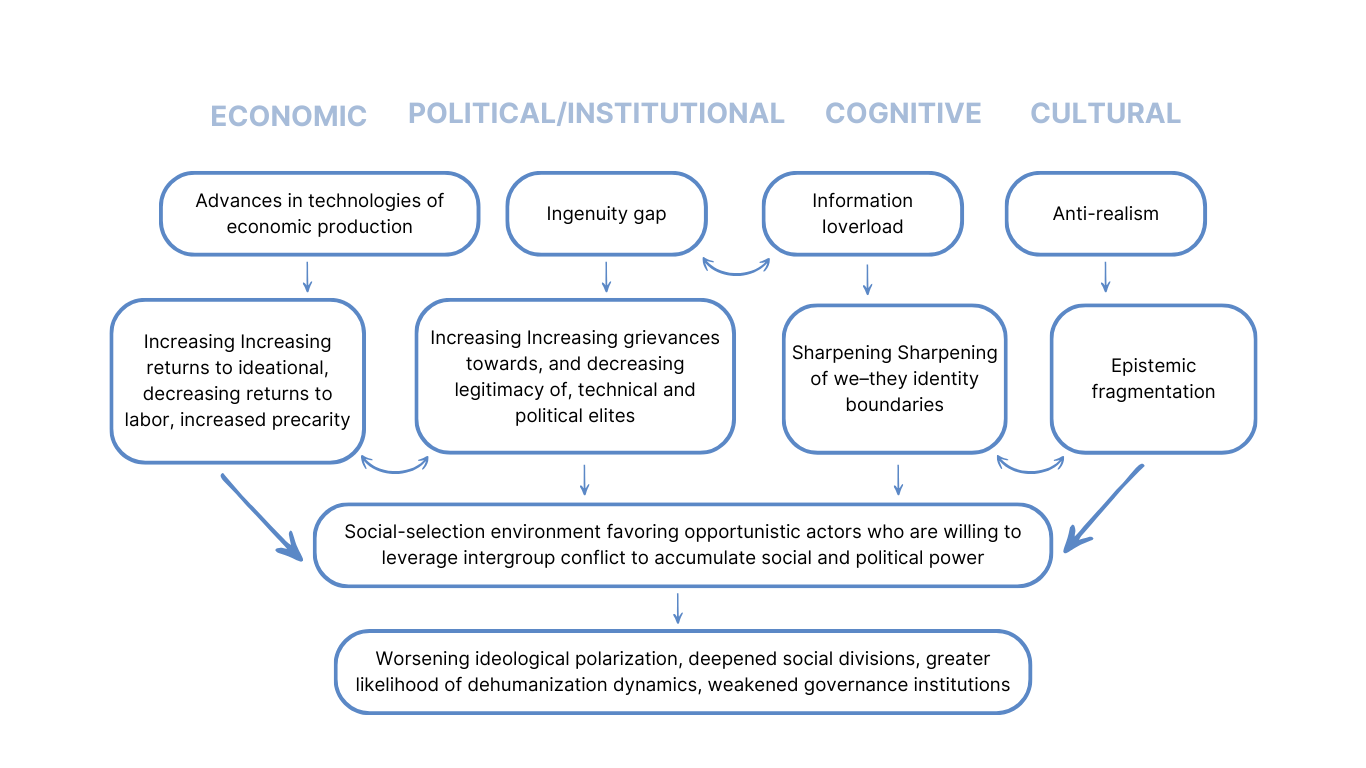Cascade Institute researchers are committed to understanding the drivers of polarization in Canada and around the world. Using these insights, we develop new solutions to counter the anti-democratic effects of growing polarization and implement them at scale.
The Anti-Polarization program seeks to discover the key forces driving increases in polarization in Canada and around the world—and how they might be countered.
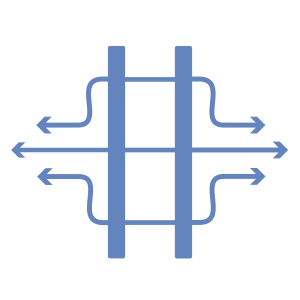
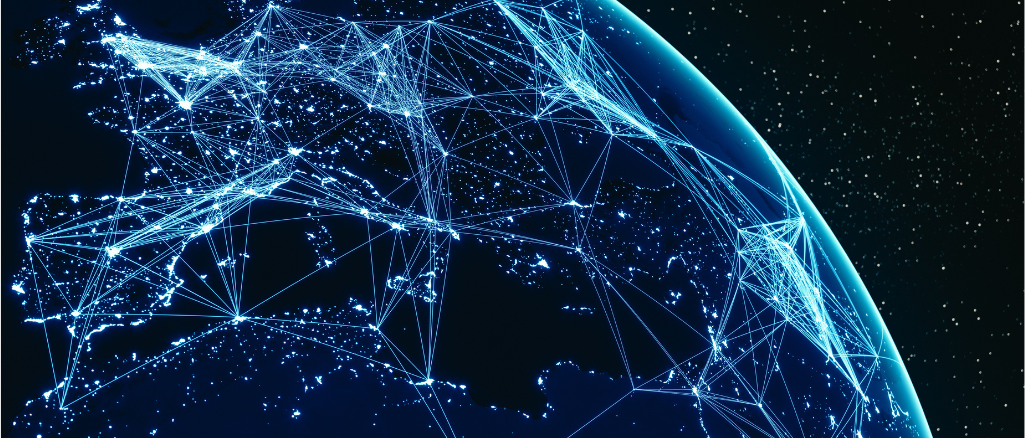
Humanity cannot address wicked challenges like climate change, infectious disease outbreaks, ideological extremism, widening inequalities, and growing global unrest if people are unable to bridge differences and engage in constructive conversations about these issues.
Affective polarization—the type of polarization in which people express disgust or disdain for those who do not think like them—is a major barrier to addressing other aspects of the polycrisis.
Using innovative tools for mapping worldviews and a complex systems approach, the AP team will first identify, then target high-leverage intervention points that can mitigate toxic expressions of polarization, while still supporting the freedom of speech and productive disagreement necessary for thriving democracies.
In 2024, the Cascade institute is building a team of subject matter experts to tackle this problem from all sides. The problem of polarization is not one merely of digital technologies, nor communication, nor education, but arises out of deep human needs for security, community, and stability. Thus our team examines the problem from an ecological perspective, looking at individual vulnerabilities, community vulnerabilities, political vulnerabilities, and cultural vulnerabilities that must be addressed to mitigate the problem.
Cascade Institute, Anti-Polarization Project, scientific foundations
Thomas Homer-Dixon, June 27, 2024
The short description below and the accompanying diagram outline the linked hypotheses guiding the Cascade Institute’s research on polarization dynamics in Western societies. We will revise these hypotheses as our research moves forward.
Each of the diagram’s vertical columns describes a proposed causal pathway that we believe is contributing to worsening ideological polarization, social division, and conflict. From left to right, we label these pathways economic, political/institutional, cognitive, and cultural.
The first two columns on the diagram’s left (i.e., those representing the economic and political/institutional pathways) identify “material” causal processes, in the sense that they concern things happening in our societies’ physical-material world. The two columns on the right (cognitive and cultural pathways) identify more “ideational” causal processes, because they mainly concern things happening in people’s heads.
The four pathways are not causally isolated from each other. The diagram indicates some of the more obvious causal links between them, although others certainly operate.
Appreciation of these four pathways’ significance as drivers of social division generally declines from left to right in the diagram. In other words, as the attention of scholars, policymakers, and commentators shifts from material to ideational causes, their understanding of causal dynamics generally weakens. For instance, although scholars have unpacked in detail the first pathway’s economic and social processes, they have substantially neglected the fourth pathway’s possibly equally powerful cultural processes.
The “economic” pathway on the diagram’s left starts at the top with long-term technological changes that have shifted income, wealth, and economic security from labor to capital. These shifts have dramatically increased certain groups’ economic precarity and, in turn, aggravated both geographic divides (especially between urban and rural communities) and social grievances. A variety of other factors—including pandemic-induced inflation, high debt levels, demographic trends, impacts of increasingly extreme weather, and rising energy cost of energy—are simultaneously worsening income and wealth differentials. Secular economic growth rates in high-income countries have declined steadily for decades (see Figure 1), a trend that has in turn promoted zero-sum perceptions of economic opportunity.
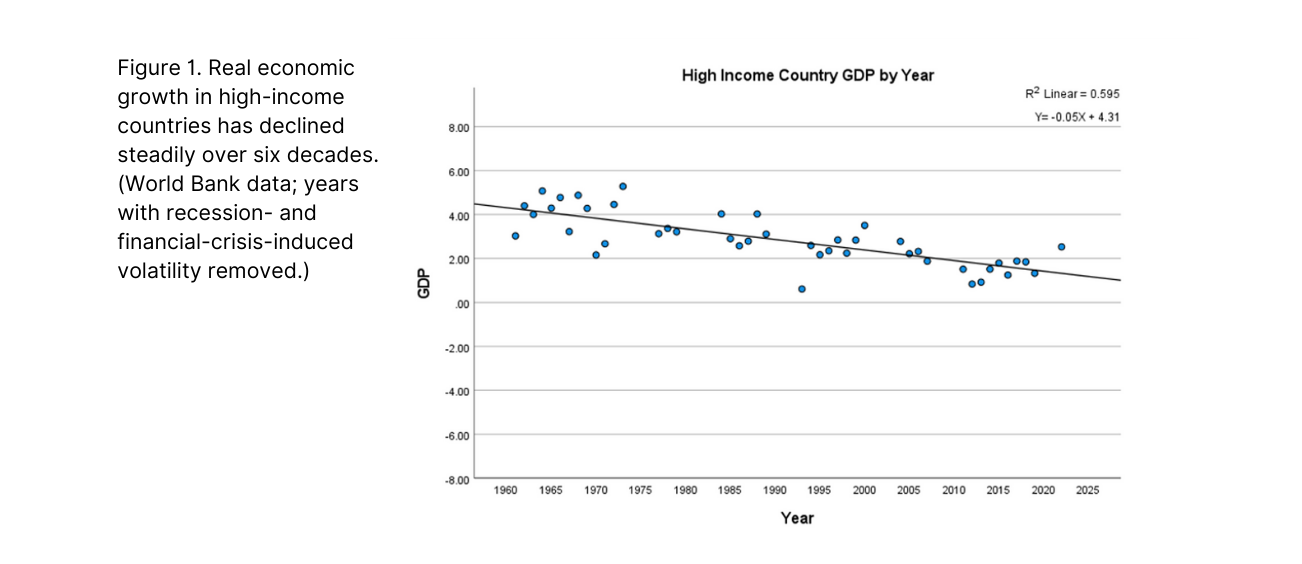
Scholars, policymakers, and commentators appreciate less the significance of the “political/institutional” pathway (second from the left). The causal chain starts with our societies’ declining ability to address critical problems, as the number and difficulty of these problems outraces our collective capacity to supply effective and just solutions. This “ingenuity gap” (Homer-Dixon, The Ingenuity Gap, Knopf, 2000) progressively erodes the moral authority (i.e., legitimacy) of political and technocratic elites and governance institutions. Why, people ask, should we continue to reward these elites with wealth and power when they aren’t protecting us from economic, health, technological, demographic, climate, and other threats?
In the third, “cognitive” pathway, information overload (arising from recent decades’ staggering increase in information availability) has shifted both message production and message reception in ways that sharpened group-identity (we/they) boundaries. Regarding message production, information overload has increased people’s incentives to shorten their messages and infuse them with psychologically “sticky” negative emotions (fear, anger, and disgust) to gain attention in a saturated information environment. Ubiquitous social-media technologies that heighten status anxiety have then encouraged people to use such messages to disparage out-groups and thereby boost their in-group status. Regarding message reception, information overload has produced severe scarcity of cognitive resources (specifically attention), which encourages people to preferentially attend to messages from “like others,” because they are more easily understood.
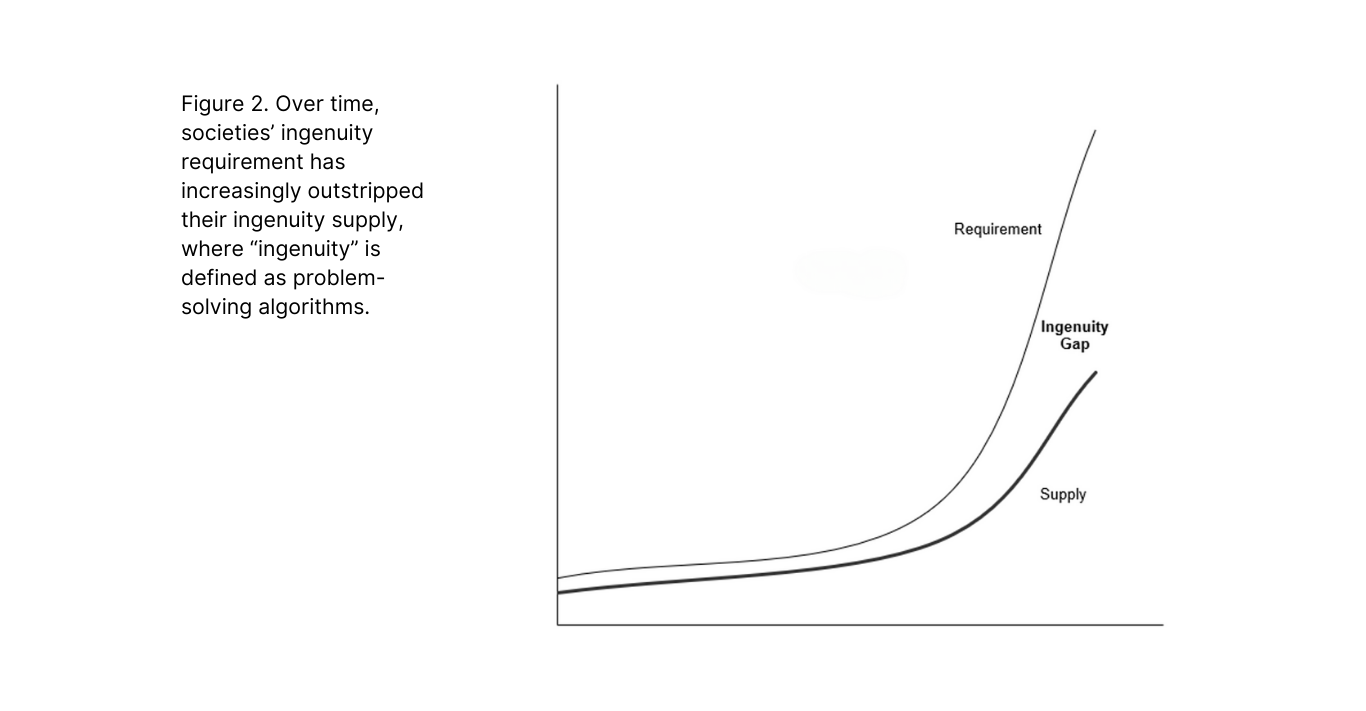
The fourth, “cultural” pathway starts in the diagram’s top right with the impact on our societies of the weakening of a shared worldview commitment to the existence of a mind-independent reality—i.e., a belief that some kind of world exists “out there” irrespective of what we think about it—and conversely, a strengthening of diverse “anti-realist” worldviews that suggest we substantially create reality, or choose among realities, through our minds.
Modern attacks on realism can be traced back nearly a century and have come from multiple quarters, including physics (specifically, the Copenhagen School, whose ontology now dominates the field), philosophy (postmodernism), social sciences (constructivism), and contemporary pop culture (including movies like “The Matrix,” “Inception,” and “Everything, Everywhere All at Once”). Technologies of virtual reality, massively multi-player games, the Meta-verse, and large language model AI are now powerfully amplifying the attractiveness of anti-realist beliefs.
The erosion of a shared understanding of reality makes solving common problems like climate change harder, because it undermines the epistemic status of science, weakens agreement on what counts as “truth,” and catalyzes fundamental disputes about sources of evidence. It also deepens social divisions, by encouraging identity groups to create their own “truth bubbles”—isolated epistemic domains of knowledge, fact, and expertise—a process Cascade Institute researchers call “epistemic fragmentation.”
The Cascade Institute proposes that these four processes are reinforcing each other, creating a social-selection (or “fitness”) environment that favors opportunistic actors willing to use intergroup conflict to accumulate social and political power. The global challenge of deepening social divisions is vastly more complex than generally understood. But that complexity doesn’t necessarily make social divisions less tractable. Complex systems are highly nonlinear, which means they often contain “leverage points,” where small interventions can cause large, beneficial change. But finding those leverage points requires, as a first and necessary step, a far better grasp of the system’s underlying causal mechanisms.
To stay informed about Cascade Institute AP team news (including upcoming job postings), please follow us on X and LinkedIn, and subscribe to our e-newsletter.

